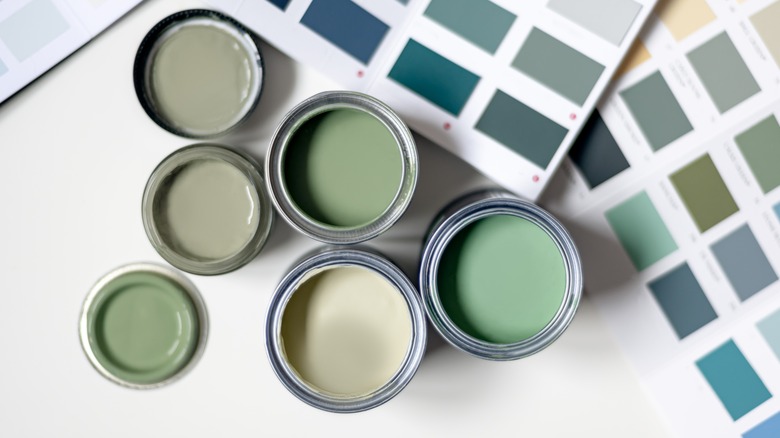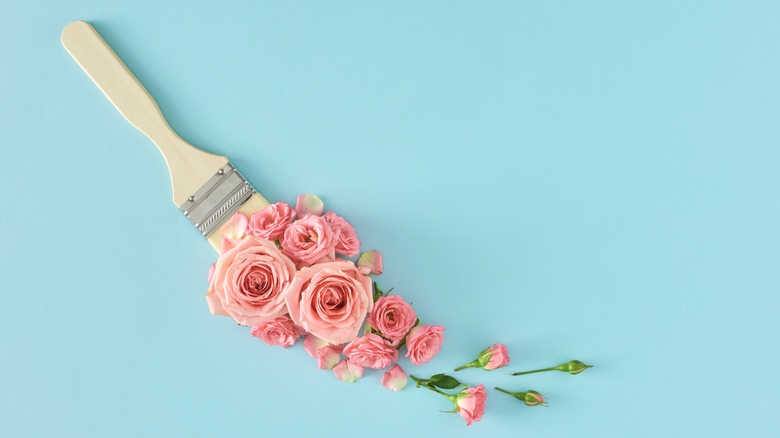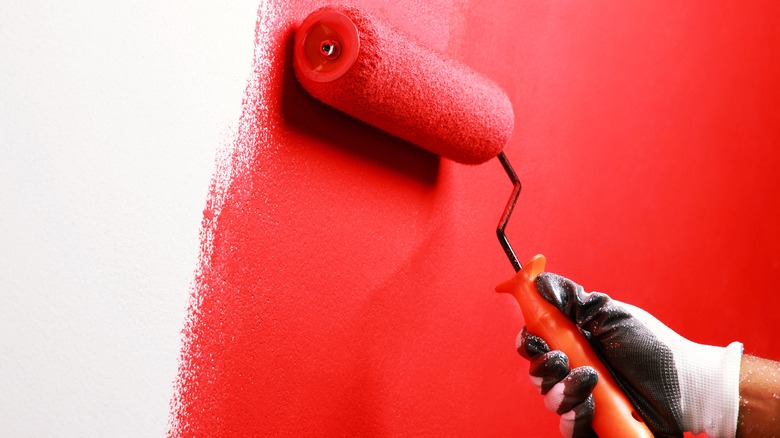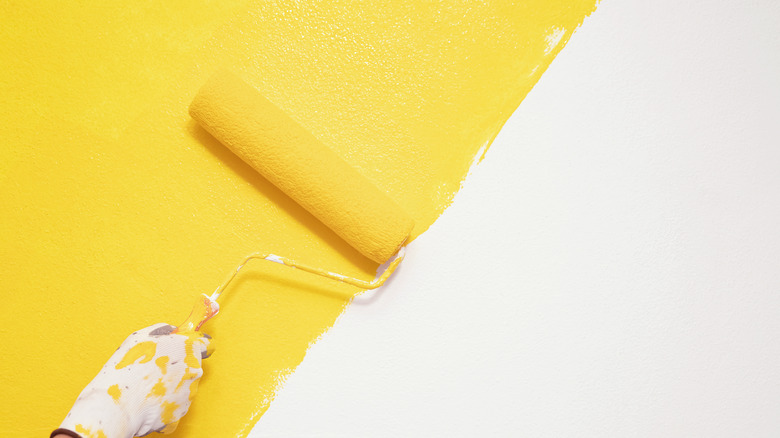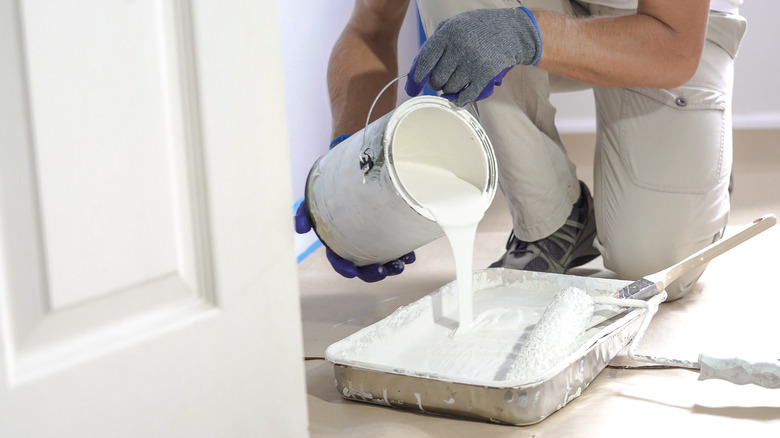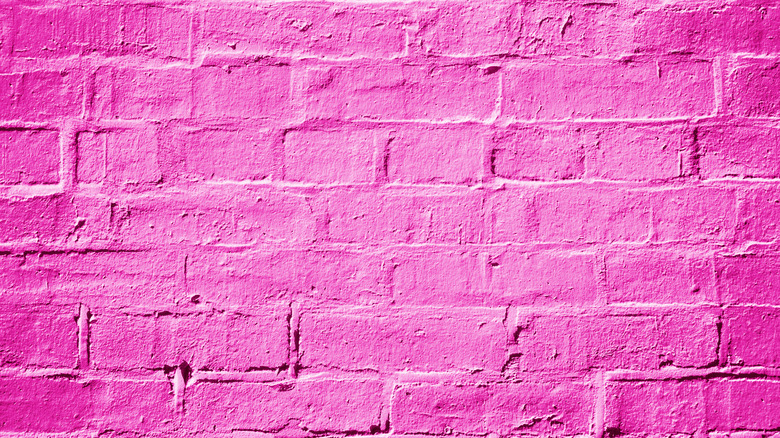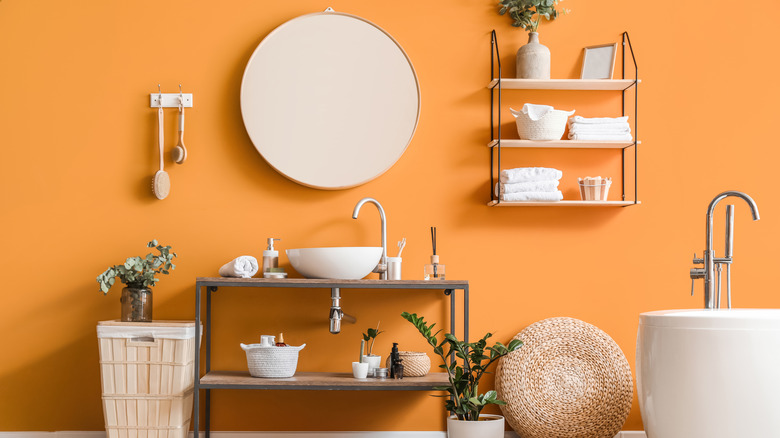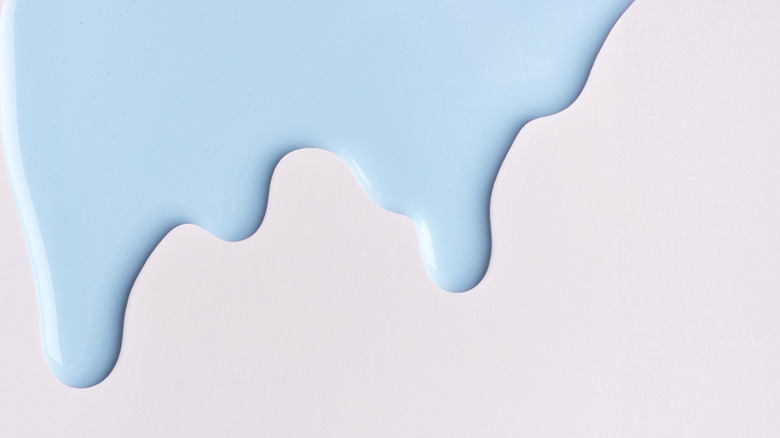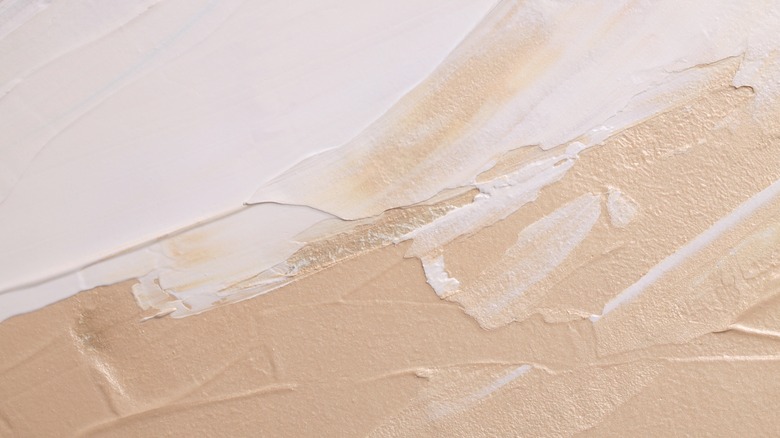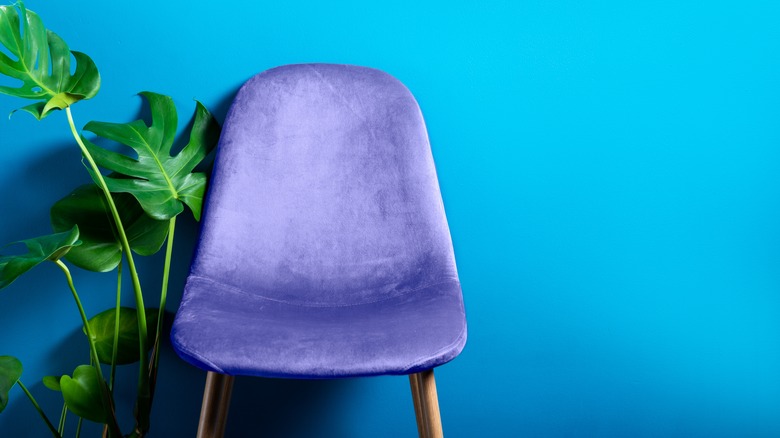10 Paint Colors You Shouldn't Use Anywhere In Your Home
When it comes to decorating your home, it makes sense that you would want it to match your personality and style preferences. Part of personalizing your space is deciding on the right paint colors for the interior and exterior of your house. Beyond just looking good, the hues and shades you choose to surround yourself with actually have a larger effect on your overall health than you may think.
For instance, Full Moon Loom notes that research has shown that implementing a mundane or boring color palette in your home may have negative effects on your health. Additionally, they explain that adding vibrancy to your space through paint or physical items can be beneficial to your health — though even among bright and happy colors, some are better suited for your home than others. That's how powerful color can be. With this in mind, there are some paint pigments you'll want to steer clear of in order to maintain an overall pleasing and calming aesthetic. To keep your home looking great and you feeling good, keep reading to learn the paint colors you should avoid entirely.
Be cautious with pastel-colored paint
Pastel paints can be tempting, especially for the walls of a kid's room or a bathroom. However, they're not always the best option. That's because, as Melanie Burstin of Homepolish tell Real Simple, they are a slippery slope since they can easily be seen as undesirable if you don't pick the right shade. "A pastel done wrong can dampen a space and create a heavy oversaturated look," Burstin explains. For instance, what you see as a soft pink may look much more aggressive, and less delicate, on your wall — which is likely not what you're going for.
Instead of painting your walls pastel hues, opt to add them into your interior in a less permanent manner. Pinkvilla shares some fool-proof ways to do so. One method is to put up posters or art featuring these soft shades on the walls. Additionally, you can use pastel colored linens in a bedroom. A comforter or even throw pillows can go a long way in adding these shades to a space in an artful way. In a living room, consider an armchair that adds additional seating along with a soft pop of color. Finally, miscellaneous decor pieces like vases or planters are a wonderful way to style a space with pastel additions.
Shy away from the color red
The color red is bold and in-your-face. For that reason, it is not the best hue to paint your house — whether inside or out. In fact, psychologist and wellbeing consultant Lee Chambers warns in Homes & Gardens that a crimson red is the worst color you could paint your living space, "Our living room often has multiple uses, and in my experience, the worst color to have emblazoned across your living room is crimson." He continues, "While red as a color promotes energy and social interaction, being in such an intense color for long periods of time can make us irritable, more aggressive, less relaxed, and even increases your heart rate. As we look to cultivate a space for us to live and restore ourselves in, crimson can literally keep us on high alert and can leave us feeling unsettled, rather than being at peace and feeling restful." Color psychologist Helen O'Keeffe also chimes in, "deep red hues are associated with passion and energy, whereas cool blue shades are considered calming and serene." Enough said.
If you don't want to completely part ways with red, Art in Context discusses the colors's different shades and how they can be incorporated into your home to get the full benefit of this color. For instance, they note that something like a red chair would pair well with a more neutral grey color scheme, as well as natural wood floors or architectural features. Alternatively, you can opt for red accessories in order to add the hue to your space in a subtle way, without it being overwhelming. Art in Context further notes that red is not an appropriate color for a bedroom, as it is too invigorating for a room that's supposed to promote calm. Because of that, many individuals will struggle to achieve quality rest in a room that is predominantly red.
There are better color options than yellow
Yellow is a bright and sunny color, but that doesn't mean it's a great paint color to choose for your home. ArtRadar Journal discusses why the color yellow might not be your best choice. First, it's known to stimulate the nervous system, which can make people feel annoyed or on edge. Additionally, yellow may cause frustration and anger, despite the fact that it has the reputation of inspiring cheerfulness. ArtRadar Journal also notes that babies are more prone to crying in yellow rooms, so as pretty as it may seem, maybe skip it for your newborn's room.
With that being said, you may be wondering how you can add yellow into your space if you want to. For Creative Juice has some ideas, including adding a yellow sofa to a living space for a pop of sunshine (bonus points if you go with an interesting texture like velvet). Yellow textiles, such as curtains or a comforter in a bedroom, are also solid options. Finally, consider doing something different with a yellow accented light fixture. This will be a statement piece in the room and is sure to brighten it up — in more ways than one.
Warm white can end up looking dingy
White is a classic interior and exterior paint color, but going with a warm white can end up making your home look dingy and dull rather than light and bright. Hey There, Home offers a useful guide on choosing the right hue of white to avoid this problem. The in-depth piece notes that there are a lot of factors to consider when it comes to choosing the appropriate shade for your home. First, natural and artificial light sources are a big factor. Additionally, the other colors in the room you're planning on painting are things you'll want to consider.
Hey There, Home goes on to explain that something homeowners find frustrating about white paint is the fact that it, oftentimes, ends up looking yellow, pink, or in some cases, purple. That's because many shades of white aren't truly white — instead, they're a very light version of a different color. Whatever undertone exists will end up becoming visible once you add the paint to your walls. That means that you need to choose a white hue with the right undertones to avoid it looking like an entirely different shade, or to avoid it looking dingy. After all, most homeowners paint their walls white in pursuit of a clean and bright look, not to attain a dull aesthetic. Since red, orange, and yellow color families are known as the warm colors, you'll want to avoid whites with those undertones within your home.
Citrus green may not land well
Green can be a very trendy color, but that doesn't mean that a zingy citrus green is the right hue to paint your walls. Some colors are simply too bright and bold to be suitable as a paint color. Zoe Warren, interior design expert at PriceYourJob, who tells Woman & Home, "Bright shades of green can almost resemble neon." She continues, "Whilst they do stand out, this can be unappealing to others and are more likely to clash with your furniture. Instead, give the illusion of a light and bright space by opting for a soft sage green on a feature wall, ideally, one you see when you first enter the room."
Woman & Home notes that this color choice could devalue your home when you go to sell, which is definitely not something a homeowner wants to spend their money doing. Tayo Oguntonade, property expert, mortgage advisor, and founder of Brickzwithtipz, agrees with Warren's take on the hue. "When you are redecorating a house, it's always important to try and capture as much of the market, potential tastes, and potential buyers as possible," Oguntonade shares. "That's why it's always wise to stay away from super bright colors, such as lime green, yellows, and bright blues. While these colors may suit some people, it's unlikely that they will be to the taste of the majority of the market." So, in the case that you do want to fulfill your lime green dreams, just be sure to paint your walls a more neutral color before you put your house on the market.
Bright pink may be too much
Barbie-inspired pink may seem like a girlie girl's dream paint color, but it's not the best choice for the walls of your home. For example, painting your house pink because it's trendy could end up being a mistake once the trend passes. This could lead to either pricey painter bills or long days repainting walls or outside exteriors.
Zillow further corroborates the fact that your home shouldn't be painted this hue. The popular home-selling site shares that nearly 100% of real estate agents recommended that sellers repaint a room in their house that is bright pink (as well as those that are bright green or purple). That's because they have a negative effect on the ability to sell a home, whereas more neutral colors tend to have a positive effect. They go on to say that you should avoid pink in your bathroom, kitchen, living room, and bedroom. Instead, shades of gray, white, and blue are favorites to make a home most appealing to buyers. The article also notes that if you are looking to go for a bold color in the bedroom, a dark blue is your best bet.
Orange can be overwhelming
Orange is another bright color that you'll want to avoid using in your home. While it can be seen as uplifting and joyous, it can also be overwhelming when overused. Hadley Court shares their tips for incorporating orange in a tasteful way that adds a splash of color without, as they lovingly note, making your room look like one big traffic cone. For instance, textiles — like rugs, curtains, or throw pillows — are a great option. You can also use textiles to add this vibrant color to the kitchen or dining room. Placemats, curtains, napkins, tablecloths, or other accents are the perfect way to incorporate a touch of brightness without allowing it to overtake the space. They also encourage homeowners to go with colors that are similar to orange — such as coral and peach. This is a more gentle way to add the hue to a space.
Another thoughtful way to get that instant mood boost is with fresh or faux flowers. An arrangement of tulips in shades of orange and pink is an instant eye-catcher when someone walks in a room. Another important thing to note are the hues that orange pairs well with. White is a no-brainer, as are shades of gray and almost any blue, from navy to cobalt. Orange can also pair nicely with green, as well as ivory, tan, or brown.
Opt for a light blue instead of a bright blue
Blue is a very popular paint color in homes, but with so many shades to choose from, it can be tough to narrow it down to the right pigment. While there are many great options, one shade of blue to rule out is bright blue. Laurel Home sheds light onto why this hue is not right for interior walls. She explains that it is actually quite easy to think you're selecting a beautiful and soothing light blue paint, only to end up with something far brighter than you expected once it's dried and on your walls.
So, what gives? Well, Laurel Bern explains that, oftentimes, we choose interior paint colors based off of photos we see online or in magazines. When we see a paint color in someone else's room — especially if it's not even in person — it will undoubtedly look different there than it will in your own space. That's because these swoon-worthy colors are seen in an immaculately-designed and professionally photographed room for an interior design website, or at the very least a highly edited social media post. Once you track down the paint color and use it yourself, it can end up looking completely different in a real life setting. That can cause a lot of disappointment. To combat this problem, once you find a hue of blue that you like, try it in the space where it will actually be used within your home — before you fully commit. That will give you a true sense of whether it's actually the blue you fell in love with, or if you need to shop around for another one.
Go for beige rather than brown
Neutral color palettes are highly desirable in homes, especially as of late. Just be warned that painting your walls brown — even if it's neutral — may not land the way that you anticipate it to. Dark brown hues can end up making a space feel smaller, and that can be overbearing. You don't want to change your perception of the size of a room just from a paint color, which is exactly what choosing a shade of brown has the capability of doing.
Lantern Lane Designs shares how you can choose the right shade of beige, rather than brown, for the neutral aesthetic you're aiming for. This can be tricky to do, as some beiges could end up looking almost orange in your space, which is probably not aligned with the neutral vibe you're going for. To avoid that issue, get samples of the different beige paint colors you're eyeing and try them on your walls. Leave the swatches up for a few days to really get a feel for how they work in your space, especially at different times of day with varying lighting. While a color online or even on a sample may look like it's exactly what you want, it may not be right for your home once you actually try it out.
Pick something besides purple
Purple is another controversial paint color. This shade is a fun addition to an interior design through other mediums, but it's best avoided as a paint color. In particular, purple walls could be detrimental in the bedroom. Logan Foley, certified sleep science coach and managing editor for the Sleep Foundation in Seattle, shared with Eating Well which paint colors are the best and worst for sleep within your home. "Your bedroom should induce sleepiness and should also play a part in keeping you asleep. This can include layout, design, sound and even smell," Foley states. She continues, "Purple and red are both very energizing colors, which can cause an increase in brain activity and heart rate." Instead, go for something like light blue, green, or good ol' white.
As the Centers for Disease Control and Prevention notes, more that 35% of Americans don't get enough sleep, which means they average less than seven hours a night. Not sleeping enough can cause, or worsen, a range of health issues, from heart disease and diabetes, to obesity and kidney disease. That goes to say that purple may be a paint color to be skipped, particularly in your bedroom.
